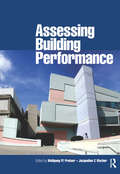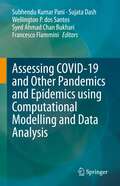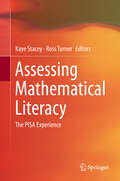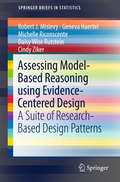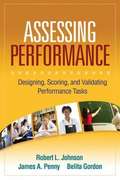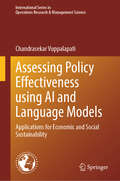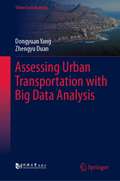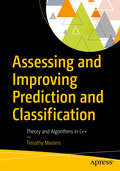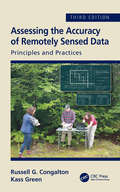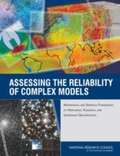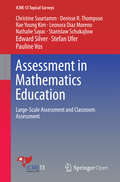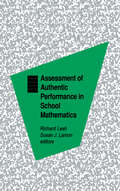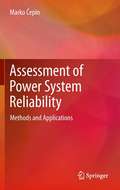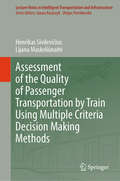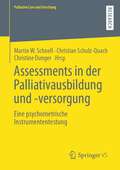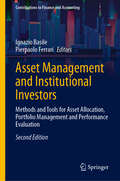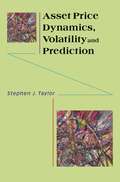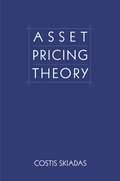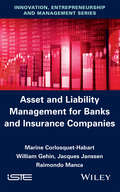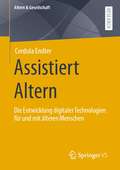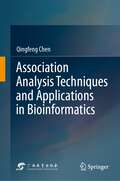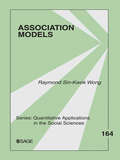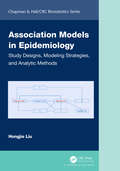- Table View
- List View
Aspekte des Unendlichen: Eine kleine Erzählung für Nichtmathematiker (Die blaue Stunde der Informatik)
by Lutz PrieseEin Buch über die Unendlichkeit Wer glaubt, dass sich Rechnen auf trockene Formeln und Zahlen beschränkt, wird mit „Aspekte des Unendlichen – Eine kleine Erzählung für Nichtmathematiker“ sein blaues Wunder erleben. Dieses Buch spricht alle Leser an, die nicht nur die Logik, sondern auch die Poesie der Unendlichkeit erforschen möchten. Anstatt Laien mit kryptischem Akademikerjargon zu verwirren, übersetzt es komplexe Sachverhalte in leicht verständliche Erklärungen. So können auch Einsteiger erfahren, welche Überraschungen die Mengenlehre bereithält. Von nicht abzählbaren Größen und unentscheidbaren Fragen Die Wissenschaft der mathematischen Unendlichkeit umfasst zahlreiche Problemstellungen, die ebenso anspruchsvoll wie spannend sind. Dazu gehören unter anderem:· die Bibliothek von Babel· diskontinuierliche Kontinua· Unmengen· Paradoxien und Antinomien Um solche theoretischen Ansätze in ihren Grundzügen zu begreifen, braucht es keinen Hochschulabschluss. Lutz Prieses Buch über die Mathematik der Unendlichkeit verwandelt abstrakte Konzepte in lebensnahe Zusammenhänge. Der Autor ist promovierter Logiker und hält seit seiner Pensionierung regelmäßig Vorlesungen zu Themen der Mathematik und Informatik. Dank seiner langjährigen Tätigkeit als Hochschuldozent gelingt es ihm, mit einer unterhaltsamen Sprache Anfänger und Experten gleichermaßen zu fesseln. Dabei steht vor allem die Verbindung zwischen mathematischen und philosophischen Problemen im Vordergrund:· Wie genau können wir mit Zahlen die unendlichen Weiten des Weltalls erfassen?· Inwiefern spiegeln die Grenzen des Rechnens die Grenzen des menschlichen Daseins wider?· Wie können wir Unvorstellbares vorstellbar machen? Prieses Buch über die Unendlichkeit in der Mathematik liefert keine endgültigen Antworten auf diese Fragen. Vielmehr regt es Leser dazu an, sich selbst auf die Suche zu machen und eigene Ideen zu entwickeln. Wie es der Titel verspricht, lädt „Aspekte des Unendlichen“ zu einer schier endlosen Reise durch die Gedankenwelt ein.
Assembly Line Balancing under Uncertain Task Time and Demand Volatility (Engineering Applications of Computational Methods #8)
by Yuchen LiThis book introduces several mathematical models in assembly line balancing based on stochastic programming and develops exact and heuristic methods to solve them. An assembly line system is a manufacturing process in which parts are added in sequence from workstation to workstation until the final assembly is produced. In an assembly line balancing problem, tasks belonging to different product models are allocated to workstations according to their processing times and precedence relationships among tasks. It incorporates two features, uncertain task times, and demand volatility, separately and simultaneously, into the conventional assembly line balancing model. A real-life case study related to the mask production during the COVID-19 pandemic is presented to illustrate the application of the proposed framework and methodology. The book is intended for graduate students who are interested in combinatorial optimizations in manufacturing with uncertain input.
Assessing Building Performance
by Wolfgang F.E. Preiser Jacqueline C. VischerThe building performance evaluation (BPE) framework emphasizes an evaluative stance throughout the six phases of the building delivery and life cycle: (1) strategic planning/needs analysis; (2) program review; (3) design review; (4) post-construction evaluation/review; (5) post-occupancy evaluation; and, (6) facilities management review/adaptive reuse.The lessons learned from positive and negative building performance are fed into future building delivery cycles. The case studies illustrate how this basic methodology has been adapted to a range of cultural contexts, and indicates the positive results of building performance assessment in a wide range of situations.
Assessing COVID-19 and Other Pandemics and Epidemics using Computational Modelling and Data Analysis
by Francesco Flammini Sujata Dash Subhendu Kumar Pani Wellington P. dos Santos Syed Ahmad Chan BukhariThis book comprehensively covers the topic of COVID-19 and other pandemics and epidemics data analytics using computational modelling. Biomedical and Health Informatics is an emerging field of research at the intersection of information science, computer science, and health care. The new era of pandemics and epidemics bring tremendous opportunities and challenges due to the plentiful and easily available medical data allowing for further analysis. The aim of pandemics and epidemics research is to ensure high-quality, efficient healthcare, better treatment and quality of life by efficiently analyzing the abundant medical, and healthcare data including patient’s data, electronic health records (EHRs) and lifestyle. In the past, it was a common requirement to have domain experts for developing models for biomedical or healthcare. However, recent advances in representation learning algorithms allow us to automatically learn the pattern and representation of the given data for the development of such models. Medical Image Mining, a novel research area (due to its large amount of medical images) are increasingly generated and stored digitally. These images are mainly in the form of: computed tomography (CT), X-ray, nuclear medicine imaging (PET, SPECT), magnetic resonance imaging (MRI) and ultrasound. Patients’ biomedical images can be digitized using data mining techniques and may help in answering several important and critical questions related to health care. Image mining in medicine can help to uncover new relationships between data and reveal new and useful information that can be helpful for scientists and biomedical practitioners. Assessing COVID-19 and Other Pandemics and Epidemics using Computational Modelling and Data Analysis will play a vital role in improving human life in response to pandemics and epidemics. The state-of-the-art approaches for data mining-based medical and health related applications will be of great value to researchers and practitioners working in biomedical, health informatics, and artificial intelligence..
Assessing Mathematical Literacy: The PISA Experience
by Kaye Stacey Ross TurnerThis book describes the design, development, delivery and impact of the mathematics assessment for the OECD Programme for International Student Assessment (PISA). First, the origins of PISA's concept of mathematical literacy are discussed, highlighting the underlying themes of mathematics as preparation for life after school and mathematical modelling of the real world, and clarifying PISA's position within this part of the mathematics education territory. The PISA mathematics framework is introduced as a significant milestone in the development and dissemination of these ideas. The underlying mathematical competencies on which mathematical literacy so strongly depends are described, along with a scheme to use them in item creation and analysis. The development and implementation of the PISA survey and the consequences for the outcomes are thoroughly discussed. Different kinds of items for both paper-based and computer-based PISA surveys are exemplified by many publicly released items along with details of scoring. The novel survey of the opportunity students have had to learn the mathematics promoted through PISA is explained. The book concludes by surveying international impact. It presents viewpoints of mathematics educators on how PISA and its constituent ideas and methods have influenced teaching and learning practices, curriculum arrangements, assessment practices, and the educational debate more generally in fourteen countries.
Assessing Model-Based Reasoning using Evidence- Centered Design: A Suite of Research-Based Design Patterns (SpringerBriefs in Statistics)
by Robert J Mislevy Geneva Haertel Michelle Riconscente Daisy Wise Rutstein Cindy ZikerThis Springer Brief provides theory, practical guidance, and support tools to help designers create complex, valid assessment tasks for hard-to-measure, yet crucial, science education standards. Understanding, exploring, and interacting with the world through models characterizes science in all its branches and at all levels of education. Model-based reasoning is central to science education and thus science assessment. Current interest in developing and using models has increased with the release of the Next Generation Science Standards, which identified this as one of the eight practices of science and engineering. However, the interactive, complex, and often technology-based tasks that are needed to assess model-based reasoning in its fullest forms are difficult to develop. Building on research in assessment, science education, and learning science, this Brief describes a suite of design patterns that can help assessment designers, researchers, and teachers create tasks for assessing aspects of model-based reasoning: Model Formation, Model Use, Model Elaboration, Model Articulation, Model Evaluation, Model Revision, and Model-Based Inquiry. Each design pattern lays out considerations concerning targeted knowledge and ways of capturing and evaluating students' work. These design patterns are available at http://design-drk. padi. sri. com/padi/do/NodeAction'state=listNodes&NODE_TYPE=PARADIGM_TYPE. The ideas are illustrated with examples from existing assessments and the research literature.
Assessing Performance
by Robert Johnson James PennyA comprehensive resource for assessment practitioners, this book provides step-by-step guidance for developing, administering, scoring, and validating a range of performance tasks, including literacy and other types of proficiency assessments. The authors explore how to establish the purpose of the assessment and how to develop scoring tools, train raters, reduce rater bias, review scores and report results, and use item-level and test-level analyses to optimize reliability and validity. Clearly written and well organized, the book includes many practical examples and accessible explanations of concepts and statistical procedures. It encompasses the breadth of applications of performance assessment today, from educational testing and the credentialing of professionals to research and program evaluation. User-friendly features include Checklists of activities to complete at each stage of a performance assessment End-of-chapter questions to facilitate self-study Annotated suggestions for further reading A quick-reference glossary of terms Examples drawn from multiple educational and professional licensure contexts
Assessing Policy Effectiveness using AI and Language Models: Applications for Economic and Social Sustainability (International Series in Operations Research & Management Science #354)
by Chandrasekar VuppalapatiThis volume uses advanced machine learning techniques to analyze government communication to evaluate policy effectiveness. The book develops policy effectiveness foundation models by cohorting historical budget policies with statistical models which are built on well reputed data sources including economic events, macroeconomic trends, and ratings and commerce terms from international institutions. By signal mining policies to the economic outcome patterns, the book aims to create a rich source of successful policy insights in terms of their effectiveness in bringing development to the poor and underserved communities to ensure the spread of wealth, social wellbeing, and standard of living to the common denomination of society rather than a selected quotient. Enabling academics and practitioners across disciplines to develop applications for effective policy interventions, this volume will be of interest to a wide audience including software engineers, data scientists, social scientists, economists, and agriculture practitioners.
Assessing Urban Transportation with Big Data Analysis (Urban Sustainability)
by Dongyuan Yang Zhengyu DuanThis book chiefly focuses on urban traffic, an area supported by massive amounts of data. The application of big data to urban traffic provides strategic and technical methods for the multi-directional and in-depth observation of complex adaptive systems, thus transforming conventional urban traffic planning and management methods. Sharing valuable insights into how big data can be applied to urban traffic, it offers a valuable asset for information technicians, traffic engineers and traffic data analysts alike.
Assessing and Improving Prediction and Classification: Theory and Algorithms in C++
by Timothy MastersThis book begins by presenting methods for performing practical, real-life assessment of the performance of prediction and classification models. It then goes on to discuss techniques for improving the performance of such models by intelligent resampling of training/testing data, combining multiple models into sophisticated committees, and making use of exogenous information to dynamically choose modeling methodologies. Rigorous statistical techniques for computing confidence in predictions and decisions receive extensive treatment. Finally, a hundred pages are devoted to the use of information theory in evaluating and selecting useful predictors. Special attention is paid to Schreiber's Information Transfer, a recent generalization of Grainger Causality. Well commented C++ code is given for every algorithm and technique. The ultimate purpose of this text is three-fold. The first goal is to open the eyes of serious developers to some of the hidden pitfalls that lurk in the model development process. The second is to provide broad exposure for some of the most powerful model enhancement algorithms that have emerged from academia in the last two decades, while not bogging down readers in cryptic mathematical theory. Finally, this text should provide the reader with a toolbox of ready-to-use C++ code that can be easily incorporated into his or her existing programs.
Assessing the Accuracy of Remotely Sensed Data: Principles and Practices, Third Edition (Mapping Science Ser.)
by Russell G. Congalton Kass GreenThe past 10 years have brought amazing changes to the technologies used to turn remotely sensed data into maps. As a result, the principles and practices necessary for assessing the accuracy of those maps have also evolved and matured. This third edition of Assessing the Accuracy of Remotely Sensed Data: Principles and Practices is thoroughly updated and includes five new chapters. Now 15 chapters long, this text is the only one of its kind to provide geospatial analysts with the requisite considerations, tools, and theory necessary to conduct successful and efficient map accuracy assessments; and map users with the knowledge to fully understand the assessment process to ensure effective use of maps. See What’s New in the Third Edition: All original chapters have been updated to include new standards, practices, and methodologies. A new chapter on planning accuracy assessments. A new chapter on assessing maps created using object-based technologies. Two case study chapters - one showcasing the assessment of maps created from traditional methods, and one on the assessment of object-based maps. Emphasis on considering and planning for positional accuracy in concert with thematic accuracy. An appendix containing the internationally recognized ASPRS Positional Accuracy Standards. A new final chapter summarizing the key concepts, considerations and lessons learned by the authors in their decades of implementing and evaluating accuracy assessments. Assessing map accuracy is complex; however, the discussions in this book, together with the many figures, tables, and case studies, clearly present the necessary concepts and considerations for conducting an assessment that is both is practical, statistically reliable, and achievable.
Assessing the Reliability of Complex Models
by National Research Council Division on Engineering and Physical Sciences Board on Mathematical Sciences And Their Applications Committee on Mathematical Foundations of Verification, Validation, and Uncertainty QuantificationAdvances in computing hardware and algorithms have dramatically improved the ability to simulate complex processes computationally. Today's simulation capabilities offer the prospect of addressing questions that in the past could be addressed only by resource-intensive experimentation, if at all. Assessing the Reliability of Complex Models recognizes the ubiquity of uncertainty in computational estimates of reality and the necessity for its quantification. As computational science and engineering have matured, the process of quantifying or bounding uncertainties in a computational estimate of a physical quality of interest has evolved into a small set of interdependent tasks: verification, validation, and uncertainty of quantification (VVUQ). In recognition of the increasing importance of computational simulation and the increasing need to assess uncertainties in computational results, the National Research Council was asked to study the mathematical foundations of VVUQ and to recommend steps that will ultimately lead to improved processes. Assessing the Reliability of Complex Models discusses changes in education of professionals and dissemination of information that should enhance the ability of future VVUQ practitioners to improve and properly apply VVUQ methodologies to difficult problems, enhance the ability of VVUQ customers to understand VVUQ results and use them to make informed decisions, and enhance the ability of all VVUQ stakeholders to communicate with each other. This report is an essential resource for all decision and policy makers in the field, students, stakeholders, UQ experts, and VVUQ educators and practitioners.
Assessment in Mathematics Education: Large-Scale Assessment and Classroom Assessment (ICME-13 Topical Surveys)
by Denisse R. Thompson Christine Suurtamm Rae Young Kim Leonora Diaz Moreno Nathalie Sayac Stanislaw Schukajlow Edward Silver Stefan Ufer Pauline VosThis book provides an overview of current research on a variety of topics related to both large-scale and classroom assessment. First, the purposes, traditions and principles of assessment are considered, with particular attention to those common to all levels of assessment and those more connected with either classroom or large-scale assessment. Assessment design based on sound assessment principles is discussed, differentiating between large-scale and classroom assessment, but also examining how the design principles overlap. The focus then shifts to classroom assessment and provides specific examples of assessment strategies, before examining the impact of large-scale assessment on curriculum, policy, instruction, and classroom assessment. The book concludes by discussing the challenges that teachers currently face, as well as ways to support them. The book offers a common language for researchers in assessment, as well as a primer for those interested in understanding current work in the area of assessment. In summary, it provides the opportunity to discuss large-scale and classroom assessment by addressing the following main themes: . Purposes, Traditions and Principles of Assessment . Design of Assessment Tasks . Classroom Assessment in Action . Interactions of Large-Scale and Classroom Assessment . Enhancing Sound Assessment Knowledge and Practices It also suggests areas for future research in assessment in mathematics education. "
Assessment of Authentic Performance in School Mathematics
by Richard Lesh Susan J. LamonThis book is the result of a conference sponsored by the Educational Testing Service and the University of Wisconsin's National Center for Research in Mathematical Sciences Education. The purpose of the conference was to facilitate the work of a group of scholars whose interests included the assessment of higher-order understandings and processes in foundation-level (pre-high school) mathematics. Discussions focused on such issues as the purposes of assessment, guidelines for producing and scoring "real-life" assessment activities, and the meanings of such terms as "deeper and higher-order understanding," "cognitive objectives," and "authentic mathematical activities." Assessment was viewed as a critical component of complex, dynamic, and continually adapting educational systems. During the time that the chapters in this book were being written, sweeping changes in mathematics education were being initiated in response to powerful recent advances in technology, cognitive psychology, and mathematics, as well as to numerous public demands for educational reform. These changes have already resulted in significant reappraisals of what it means to understand mathematics, of the nature of mathematics teaching and learning, and of the real-life situations in which mathematics is useful. The challenge was to pursue assessment-related initiatives that are systematically valid, in the sense that they work to complement and enhance other improvements in the educational system rather than act as an impediment to badly needed curriculum reforms. To address these issues, most chapters in this book focus on clarifying and articulating the goals of assessment and instruction, and they stress the content of assessment above its mode of delivery. Computer- or portfolio-based assessments are interpreted as means to ends, not as ends in themselves. Assessment is conceived as an ongoing documentation process, seamless with instruction, whose quality hinges upon its ability to provide complete and appropriate information as needed to inform priorities in instructional decision making. This book tackles some of the most complicated issues related to assessment, and it offers fresh perspectives from leaders in the field--with the hope that the ultimate consumer in the instruction/assessment enterprise, the individual student, will reclaim his or her potential for self-directed mathematics learning.
Assessment of Power System Reliability: Methods and Applications
by Marko ČepinThe importance of power system reliability is demonstrated when our electricity supply is disrupted, whether it decreases the comfort of our free time at home or causes the shutdown of our companies and results in huge economic deficits. The objective of Assessment of Power System Reliability is to contribute to the improvement of power system reliability. It consists of six parts divided into twenty chapters. The first part introduces the important background issues that affect power system reliability. The second part presents the reliability methods that are used for analyses of technical systems and processes. The third part discusses power flow analysis methods, because the dynamic aspect of a power system is an important part of related reliability assessments. The fourth part explores various aspects of the reliability assessment of power systems and their parts. The fifth part covers optimization methods. The sixth part looks at the application of reliability and optimization methods. Assessment of Power System Reliability has been written in straightforward language that continues into the mathematical representation of the methods. Power engineers and developers will appreciate the emphasis on practical usage, while researchers and advanced students will benefit from the simple examples that can facilitate their understanding of the theory behind power system reliability and that outline the procedure for application of the presented methods.
Assessment of the Quality of Passenger Transportation by Train Using Multiple Criteria Decision Making Methods (Lecture Notes in Intelligent Transportation and Infrastructure)
by Henrikas Sivilevičius Lijana MaskeliūnaitėThis book presents a study of the rail travel process, where passengers under normal (non-emergency) conditions choose their own itinerary considering the offered timetable, travel expenses, comfort, potential risks, quality of service and other factors. Upon identifying many criteria that are critical for this kind of transport, the authors show how to use them to generate a multicriteria mathematical models to calculate the quality of the travel. The model is used to compare road, rail, and air transport alternatives against each other. The results are presented, together with the technical details to build up the model. This book is intended for students, researchers and decision makers working on the development and quality assessment of rail transport.
Assessments in der Palliativausbildung und -versorgung: Eine psychometrische Instrumententestung (Palliative Care und Forschung)
by Martin W. Schnell Christine Dunger Christian Schulz-QuachDie Steuerung der Patientenbehandlung in der Palliativversorgung erfolgt durch Assessmentinstrumente. Sie erfassen den Zustand des Patienten, seine Symptome, Bedürfnisse und erleichtern die weitere Planung. Eine gelungene Verwendung derartiger Instrumente beinhaltet, dass sie gültig, sensibel und zuverlässig sind. Diesem Nachweis dient die Instrumententestung. Am Beispiel von Assessments der Palliativversorgung wird in diesem Band eine solche Testung vorgeführt, erläutert und reflektiert.
Asset Management and Institutional Investors: Methods and Tools for Asset Allocation, Portfolio Management and Performance Evaluation (Contributions to Finance and Accounting)
by Pierpaolo Ferrari Ignazio BasileThis second edition of the book analyses the latest developments in investment management policy for institutional investors. It is divided into four parts, which have been updated to include the newest approaches and strategies in asset allocation, portfolio management and performance evaluation. The first part analyses the different types of institutional investors, i.e. institutions that professionally manage portfolios of financial and real assets on behalf of a wide range of individuals. This part goes on with an in-depth analysis of the economic, technical and regulatory characteristics of the various categories of investment funds and of other types of asset management products, which have a high rate of substitutability with investment funds and represent their natural competitors. The second part of the book identifies and investigates the stages of the investment portfolio management. Given the importance of strategic asset allocation in explaining the ex post performance of any type of investment portfolio, this part provides an in-depth analysis of asset allocation methods, illustrating the different theoretical and operational solutions available to institutional investors. The third part describes performance assessment, its breakdown and risk control, with an in-depth examination of performance evaluation techniques, returns-based style analysis approaches and performance attribution models. Finally, the fourth part deals with the subject of diversification into alternative asset classes, identifying the common characteristics and their possible role within the framework of investment management policy. This part analyses hedge funds, private equity, private debt, real estate, infrastructures, commodities and currency overlay techniques.
Asset Price Dynamics, Volatility, and Prediction
by Stephen J. TaylorThis book shows how current and recent market prices convey information about the probability distributions that govern future prices. Moving beyond purely theoretical models, Stephen Taylor applies methods supported by empirical research of equity and foreign exchange markets to show how daily and more frequent asset prices, and the prices of option contracts, can be used to construct and assess predictions about future prices, their volatility, and their probability distributions. Stephen Taylor provides a comprehensive introduction to the dynamic behavior of asset prices, relying on finance theory and statistical evidence. He uses stochastic processes to define mathematical models for price dynamics, but with less mathematics than in alternative texts. The key topics covered include random walk tests, trading rules, ARCH models, stochastic volatility models, high-frequency datasets, and the information that option prices imply about volatility and distributions. Asset Price Dynamics, Volatility, and Prediction is ideal for students of economics, finance, and mathematics who are studying financial econometrics, and will enable researchers to identify and apply appropriate models and methods. It will likewise be a valuable resource for quantitative analysts, fund managers, risk managers, and investors who seek realistic expectations about future asset prices and the risks to which they are exposed.
Asset Pricing Theory (Princeton Series in Finance)
by Costis SkiadasAsset Pricing Theory is an advanced textbook for doctoral students and researchers that offers a modern introduction to the theoretical and methodological foundations of competitive asset pricing. Costis Skiadas develops in depth the fundamentals of arbitrage pricing, mean-variance analysis, equilibrium pricing, and optimal consumption/portfolio choice in discrete settings, but with emphasis on geometric and martingale methods that facilitate an effortless transition to the more advanced continuous-time theory. Among the book's many innovations are its use of recursive utility as the benchmark representation of dynamic preferences, and an associated theory of equilibrium pricing and optimal portfolio choice that goes beyond the existing literature. Asset Pricing Theory is complete with extensive exercises at the end of every chapter and comprehensive mathematical appendixes, making this book a self-contained resource for graduate students and academic researchers, as well as mathematically sophisticated practitioners seeking a deeper understanding of concepts and methods on which practical models are built. Covers in depth the modern theoretical foundations of competitive asset pricing and consumption/portfolio choice Uses recursive utility as the benchmark preference representation in dynamic settings Sets the foundations for advanced modeling using geometric arguments and martingale methodology Features self-contained mathematical appendixes Includes extensive end-of-chapter exercises
Asset and Liability Management for Banks and Insurance Companies
by Jacques Janssen Raimondo Manca William Gehin Marine Corlosquet-HabartThis book introduces ALM in the context of banks and insurance companies. Although this strategy has a core of fundamental frameworks, models may vary between banks and insurance companies because of the different risks and goals involved. The authors compare and contrast these methodologies to draw parallels between the commonalities and divergences of these two services and thereby provide a deeper understanding of ALM in general.
Assistiert Altern: Die Entwicklung digitaler Technologien für und mit älteren Menschen (Altern & Gesellschaft)
by Cordula EndterDigitale Assistenztechnologien sollen ältere Menschen unterstützen, auch bei altersbedingten Einschränkungen möglichst lange selbstbestimmt leben zu können. Wie aber werden diese Technologien entwickelt? Welche Vorstellungen von Alter(n) spielen dabei eine Rolle? Wie werden ältere Menschen in die Technikentwicklung eingebunden? Und welche Ziele verfolgen Politik, Technikentwickler*innen und Gesellschaft mit der Entwicklung digitaler Asssistenztechnologien? Das Buch gibt anhand einer ethnographischen Studie Antworten auf diese Fragen und zeigt auf, welche Voraussetzungen in Forschung und Entwicklung geschaffen werden müssen, damit digitale Technologien den Bedürfnissen älterer Menschen entsprechen und sie in ihrem Alltag unterstützen.
Association Analysis Techniques and Applications in Bioinformatics
by Qingfeng ChenAdvances in experimental technologies have given rise to tremendous amounts of biology data. This not only offers valuable sources of data to help understand biological evolution and functional mechanisms, but also poses challenges for accurate and effective data analysis. This book offers an essential introduction to the theoretical and practical aspects of association analysis, including data pre-processing, data mining methods/algorithms, and tools that are widely applied for computational biology. It covers significant recent advances in the field, both foundational and application-oriented, helping readers understand the basic principles and emerging techniques used to discover interesting association patterns in diverse and heterogeneous biology data, such as structure-function correlations, and complex networks with gene/protein regulation. The main results and approaches are described in an easy-to-follow way and accompanied by sufficientreferences and suggestions for future research. This carefully edited monograph is intended to provide investigators in the fields of data mining, machine learning, artificial intelligence, and bioinformatics with a profound guide to the role of association analysis in computational biology. It is also very useful as a general source of information on association analysis, and as an overall accompanying course book and self-study material for graduate students and researchers in both computer science and bioinformatics.
Association Models (Quantitative Applications in the Social Sciences)
by Raymond Sin-Kwok WongOffers readers invaluable guidance on handling cross-classified data Broadening the scope of association models beyond the typical sociological and psychological fields, author Raymond S. Wong shows readers how to analyze and comprehend any social science data presented in cross-classified formats. Through a careful exposition of various association models, the text examines the underlying structure of odds-ratios, offering a unified framework for students and researchers in the process. Rich illustrative examples (from data generated by the General Social Survey and other sources) demonstrate why and how association models are a better option than conventional log-linear models or non-parametric specifications. This resource is appropriate for graduate students and researchers across the social and behavioral sciences who need to chose and apply the appropriate statistical tools to decipher and interpret cross-classified data.
Association Models in Epidemiology: Study Designs, Modeling Strategies, and Analytic Methods (Chapman & Hall/CRC Biostatistics Series)
by Hongjie LiuAssociation Models in Epidemiology: Study Designs, Modeling Strategies, and Analytic Methods is written by an epidemiologist for graduate students, researchers, and practitioners who will use regression techniques to analyze data. It focuses on association models rather than prediction models. The book targets students and working professionals who lack bona fide modeling experts but are committed to conducting appropriate regression analyses and generating valid findings from their projects. This book aims to offer detailed strategies to guide them in modeling epidemiologic data.Features Custom-Tailored Models: Discover association models specifically designed for epidemiologic study designs. Epidemiologic Principles in Action: Learn how to apply and translate epidemiologic principles into regression modeling techniques. Model Specification Guidance: Get expert guidance on model specifications to estimate exposure-outcome associations, accurately controlling for confounding bias. Accessible Language: Explore regression intricacies in user-friendly language, accompanied by real-world examples that make learning easier. Step-by-Step Approach: Follow a straightforward step-by-step approach to master strategies and procedures for analysis. Rich in Examples: Benefit from 120 examples, 77 figures, 86 tables, and 174 SAS® outputs with annotations to enhance your understanding. Book website located here. Crafted for two primary audiences, this text benefits graduate epidemiology students seeking to understand how epidemiologic principles inform modeling analyses and public health professionals conducting independent analyses in their work. Therefore, this book serves as a textbook in the classroom and as a reference book in the workplace. A wealth of supporting material is available for download from the book’s CRC Press webpage. Upon completing this text, readers should gain confidence in accurately estimating associations between risk factors and outcomes, controlling confounding bias, and assessing effect modification.


